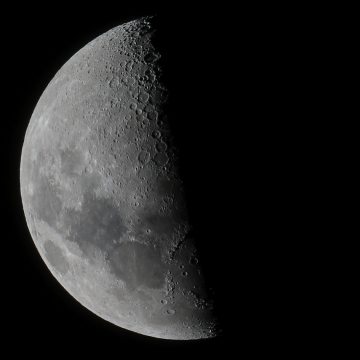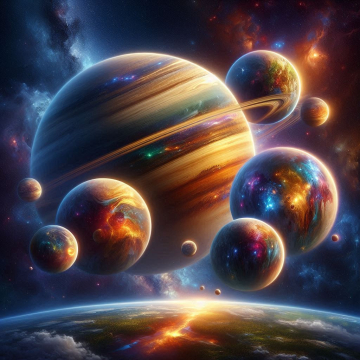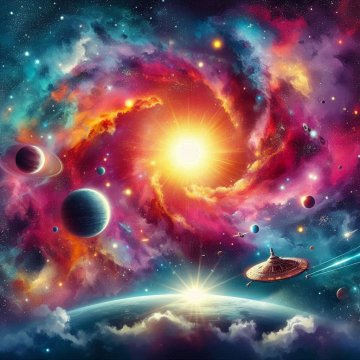The Moon, our bright and mysterious celestial companion, has fascinated humanity for millennia. Its cycle of phases, which goes from the New Moon to the Full Moon and vice versa, has been the object of observation and study since ancient times. Each lunar phase has its own beauty and meaning.
Moon phases
Before we dive into the differences between the Full Moon and the New Moon, it is important to understand the lunar cycle in its entirety. The Moon goes through a complete cycle of phases in approximately 29.5 days, known as a lunar month or synodic month. During this period, the Moon goes through several stages, each of which has a different appearance and meaning. The four main phases of the lunar cycle are:
- New Moon: In this phase, the Moon is between the Earth and the Sun, so its illuminated side is not visible from the Earth. It is a starting point for the new lunar cycle and generally marks the beginning of a period of growth and renewal.
- First Quarter : After the New Moon, the Moon begins to grow in visibility. In this phase, only the right half of the Moon is visible from Earth, forming an illuminated "D" in the sky.
- Full Moon: The Full Moon occurs when the Moon is directly opposite the Sun in the sky. In this phase, the entire illuminated side of the Moon is visible from Earth, creating a complete circular image in the night sky.
- Last Quarter: After the Full Moon, the Moon begins to decrease in visibility. In this phase, only the left half of the Moon is visible from Earth, forming an illuminated "C" in the sky.
Full Moon: The Queen of the Night
The Full Moon is one of the most recognizable and exciting phases of the lunar cycle. During this phase, the Moon appears as a bright, complete disk in the night sky. This is a stunning view that has inspired poets, artists, and nature lovers throughout history. But what are the real characteristics and meanings behind the Full Moon?
Characteristics of the Full Moon
Luminosity: During the Full Moon, the Moon is so bright that it can illuminate the night landscape significantly. This facilitates vision in the dark and is useful for outdoor activities such as hiking and wildlife watching.
Night of the Wolves : The Full Moon has often been associated with the "Night of the Wolves" legends. Although wolves do not become more dangerous during this phase, their howling is more audible due to the greater luminosity of the Moon, which has led to the popular belief that they are more active.
Rituals and Traditions: The Full Moon has been a focal point for rituals and traditions in many cultures. Some people believe that this moon phase is a powerful time for meditation, manifesting desires, and celebrating wholeness.
Meanings and Beliefs
The Full Moon is linked to a variety of meanings and beliefs in different cultures and spiritual practices. Some of these interpretations include:
Culmination and Plenitude: The Full Moon symbolizes the culmination of a cycle, marking a moment of plenitude and abundance.
Change and Transformation: For some, this lunar phase represents a period of personal change and transformation, where old patterns can be released and new opportunities embraced.
Reflection and Clarity : The intense light of the Full Moon is often associated with mental clarity and the ability to see things more clearly.
Magic and Mystery : In many esoteric traditions, the Full Moon is considered an auspicious time to perform magic rituals and connect with mystical energies.
New Moon: The Beginning of a New Cycle
The New Moon, on the other hand, marks the beginning of a new lunar cycle and is the opposite of the Full Moon in terms of visibility. During this phase, the Moon is aligned between the Earth and the Sun, and its illuminated side is not visible from Earth. What are the characteristics and meanings behind the New Moon?
Characteristics of the New Moon
The New Moon is a fascinating lunar phase that is distinguished by its marked absence of light. During this period, the Moon is aligned directly between the Earth and the Sun, resulting in the illuminated part of the Moon being on the opposite side of our planet, making it virtually invisible in the night sky. This lack of luminosity is the most distinctive characteristic of the New Moon and what differentiates it significantly from other lunar phases.
The darkness of the New Moon provides some unique and exciting opportunities:
Beginning of a New Cycle: The New Moon marks the beginning of a new lunar cycle, making it a symbolic starting point. It is a good time to leave the past behind and look to the future with hope and determination. People often use this phase to set intentions and goals for the upcoming period, considering it a magical time for planning and preparation.
Starry Sky: The lack of lunar light at the New Moon creates an exceptionally dark and starry night sky. This makes it easier to observe other celestial bodies, such as stars, planets, and astronomical events. Astronomers and astronomy enthusiasts especially appreciate this phase for observing celestial phenomena, such as meteor showers and eclipses.
Spirituality and Reflection: The darkness of the New Moon also makes it a favorable time for introspection and spiritual connection. Many people find that this lunar phase provides a quiet space for meditation and contemplation. The absence of moonlight is believed to allow for a greater connection with oneself and spiritual energies.
Renewal and Reset : The New Moon symbolizes the opportunity to restart and leave the old behind. Just as the Moon itself is temporarily hidden, we are urged to hide our previous worries and limitations to make way for a new beginning. This phase invites us to free ourselves from past burdens and embrace a future full of possibilities.
Meanings and Beliefs
The New Moon also has a number of associated meanings and beliefs:
- Renewal and Reset: The New Moon symbolizes the opportunity to reset, leave the past behind and start anew.
- Planning and Preparation: It is a suitable time for planning and preparing for future projects, as intentions set at this time are believed to have special power.
- Fertility: In some cultures, the New Moon is associated with fertility and is considered an auspicious time to conceive.
- Spirituality and Meditation: Many people use the New Moon as a period for introspection, meditation, and spiritual connection.
Both lunar phases have a special place in culture, spirituality and night sky viewing. Let us remember that the Moon, in all its phases, continues to be an inexhaustible source of inspiration and wonder for humanity.






